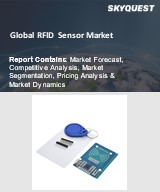
Report ID: SQMIG20O2012

Report ID:
SQMIG20O2012 |
Region:
Global |
Published Date: May, 2024
Pages:
197
|
Tables:
92 |
Figures:
76
Global RFID Sensors Market size was valued at USD 18.07 billion in 2022 and is poised to grow from USD 20.78 billion in 2023 to USD 55.66 billion by 2031, growing at a CAGR of 15.1% during the forecast period (2024-2031).
RFID, or Radiofrequency Identification, constitutes a wireless system composed of tags and readers. Acting both as a transmitter and receiver via antennas, the reader emits radio waves and captures signals from RFID tags. These tags, categorized as passive or active tags, employ radio waves to transmit their identity and pertinent data to nearby readers. The technology boasts widespread application across various sectors, including monitoring goods throughout the supply chain, tracking parts during transportation to manufacturing lines, asset tracing, implementing security measures and facilitating secure payment methods that circumvent traditional currency exchanges.
The RFID sensors market is expected to witness a robust growth in the upcoming years due to escalating needs across various sectors such as asset tracking, inventory management, and security enhancement. With the increasing adoption of real-time location systems (RTLS), sensor networks, and 5G infrastructure, the relevance of RFID devices has been significantly elevated in today's interconnected landscape. These technological advancements, coupled with the pervasive influence of the Internet of Things (IoT), are reshaping market dynamics and fueling demand for RFID solutions that can seamlessly integrate with evolving infrastructures.
Furthermore, the market outlook is sustained by the growing emphasis on resource optimization and operational efficiency across industries. Businees are increasingly shifting towards RFID technology to streamline their processes, reduce costs and improve productivity. Additionally, the surge in demand for RFID devices is driven by the need to strengthen security and safety measures in various applications, ranging from supply chain logistics to access control systems. As these technological forces continue to intertwine, RFID devices are positioned to play an increasingly pivotal role in meeting the expanding demand and addressing the evolving requirements of a quickly developing market landscape.
At the same time, the convergence of RFID technology with emerging trends such as IoT, AI and machine learning is set to unlock new opportunities for innovation and optimization. with the help of AI-driven analytics, organizations can derive actionable insights from RFID data, enabling predictive maintenance, demand forecasting, and personalized customer experiences. This integration of RFID with AI technologies not only enhances the operational efficiency but also drives the strategic decision-making. As businesses seek to stay ahead in a competitive landscape, the combination of RFID sensors with AI holds the potential to revolutionize processes, drive value creation, and unlock new avenues for growth across industries.
Our industry expert will work with you to provide you with customized data in a short amount of time.
REQUEST FREE CUSTOMIZATIONWant to customize this report? This report can be personalized according to your needs. Our analysts and industry experts will work directly with you to understand your requirements and provide you with customized data in a short amount of time. We offer $1000 worth of FREE customization at the time of purchase.

Report ID: SQMIG20O2012